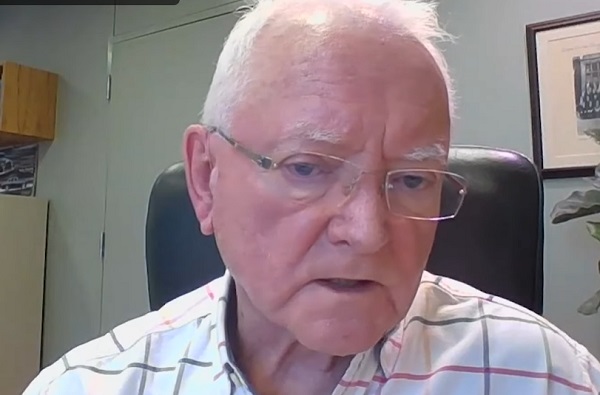Alberta
Alberta going after entrepreneurs and immigrants working as health-care professionals
Improving the Alberta Advantage Immigration Program
Changes to the Alberta Advantage Immigration Program (AAIP) will make it easier for in-demand workers and entrepreneurs to become permanent residents.
Alberta’s economy has momentum, and Alberta’s government is committed to further growth and diversification so the province remains the economic engine of Canada. In 2022, nearly 50,000 people from around the world chose Alberta as the place to invest, work and raise their families.
AAIP is an economic immigration program that enables Alberta to nominate qualified workers in in-demand sectors for permanent residency. By improving the program, Alberta will be more competitive in attracting skilled newcomers from across the world.
“Alberta is a land of opportunity. In our province, you can find the career you want, take home a strong and regular paycheque, and still spend time with family and friends. Not only do people around the world want to come here, we want them to come here to be a part of our communities and our prosperity, and help Alberta continue to grow and succeed.”
Alberta’s government is making five improvements to the AAIP that will help both businesses and international skilled workers.
Changes to the Rural Entrepreneur and Rural Renewal streams will help Alberta’s rural communities remain vibrant and grow. A lowered investment threshold of $100,000 for the Rural Entrepreneur Stream will will open the door to additional qualified entrepreneurs who wish to establish or purchase an existing business in participating rural Alberta communities. Removing the requirement for a letter from a settlement agency under the Rural Renewal Stream will help rural communities attract, recruit and welcome newcomers based on local needs.
“Bringing more workers needed in the province will be key to continuing to grow Alberta’s economy and meeting our labour shortages. These changes to AAIP show our commitment to making Alberta one of the best places in the world to put down roots, contribute positively to your community and be prosperous.”
Alberta has the best front-line health care workers in the world and the province will work to have the right supports in place to ensure Albertans get the care they need when and where they need it. A new, dedicated pathway to attract medical professionals to Alberta means that up to 30 per cent of Alberta’s Express Entry Stream allocation in 2023 will be reserved for health-care professionals with an Alberta job offer from a health-care sector employer and who meet the requirements to work in one of the eligible health occupations.
Two more changes will see a new phone line that directly connects AAIP staff members with clients and collaboration with the federal Economic Mobility Pathways Pilot. Participating in this pilot will help refugees with the skills and qualifications needed in Canada to immigrate through existing economic programs.
“These policy changes are aimed squarely at filling needed skills gaps, boosting vibrancy in rural communities, and creating more economic opportunity for refugees. We applaud these moves to enhance economic immigration in a way that is responsive to specific provincial needs.”
“From HV Global Immigration, we would like to thank Minister Rajan Sawhney for listening and proactively implementing reasonable changes to the AAIP. Apart from the other improvements, change in minimum investment at AAIP’s Rural Entrepreneur Stream would definitely help new and prospective immigrants to qualify for this program. This change will generate more revenue and create jobs for Albertans. Last, but not least, the new information phone line is going to be a big relief. Thanks once again Minister Sawhney for your hard work and listening to our ideas and solutions.”
Quick facts
- Alberta currently has about 100,000 job openings across the province.
- Alberta is forecasting a cumulative job shortage of 33,100 workers by 2025 across several occupations, skill levels and sectors (source: Alberta’s Occupational Outlook, 2021-2030).
- Immigration, Refugees and Citizenship Canada sets AAIP’s annual nomination limits.
- Alberta recently received an increase in nominations:
- 9,750 nominations in 2023
- 10,140 nominations in 2024 (estimated)
- 10,849 nominations in 2025 estimated)
- Alberta recently received an increase in nominations:
Alberta
Medical regulator stops short of revoking license of Alberta doctor skeptic of COVID vaccine

From LifeSiteNews
The Democracy Fund has announced that COVID-skeptic Dr. Roger Hodkinson will retain his medical license after a successful appeal against allegations of ‘unprofessional conduct’ by the College of Physicians and Surgeons of Alberta.
A doctor who called for officials to be jailed for being complicit in the “big kill” caused by COVID measures will get to keep his medical license thanks to a ruling by a Canadian medical regulator.
The Democracy Fund (TDF) announced in an April 4 press release that one of its clients, Dr. Roger Hodkinson, will retain his medical license after filing an appeal with the College of Physicians and Surgeons of Alberta (CPSA) over allegations of “unprofessional conduct regarding 17 public statements made in November 2020 and April 2021.”
Hodkinson had routinely argued against the dictates of public health and elected officials and “presented an alternative perspective on COVID-19, including the efficacy of masking and vaccines,” TDF noted.
In 2021, Hodkinson and Dr. Dennis Modry publicly blasted the then-provincial government of Alberta under Premier Jason Kenney for “intimidating” people “into compliance” with COVID-19 lockdowns.
In 2022, Hodkinson said that leaders in Canada and throughout the world have perpetrated the “biggest kill ever in medicine’s history” by coercing people into taking the experimental COVID injections and subjecting them to lengthy lockdowns.
These statements, among others, led the CPSA to claim that Hodkinson had promoted inaccurate or misleading information. “However, following negotiations with lawyers for The Democracy Fund, the CPSA limited its claims to arguing that Dr. Hodkinson’s comments violated the ethical code and extended beyond the scope of a general pathologist.”
Thus, Hodkinson did not “concede that any of his statements were false,” but “acknowledged that his criticisms of other physicians technically breached the Code of Ethics and Professionalism,” the group explained. “He also admitted that he should have clarified that his views were outside the scope of a general pathologist.”
Instead of having his license revoked, TDF stated that Dr. Hodkinson received a “caution” and will have to “complete an online course on influence and advocacy.”
“However, he did not concede that any of his statements were misinformation, nor did the tribunal make such a determination,” noted lawyer Alan Honner.
While Hodkinson received a slap on the wrist, a number of Canadian doctors have faced much harsher sanctions for warning about the experimental vaccines or other COVID protocols such as lockdowns, including the revocation of their medical licenses, as was the case with Dr. Mark Trozzi and others.
Some of Hodkinson’s warnings seem to have been vindicated by the current Alberta government under Premier Danielle Smith, who commissioned Dr. Gary Davidson to investigate the previous administration’s handling of COVID-19.
Davidson’s report, which was made public earlier this year, recommended the immediately halt of the experimental jabs for healthy children and teenagers, citing the risks the shots pose.
Alberta
Province introducing “Patient-Focused Funding Model” to fund acute care in Alberta

Alberta’s government is introducing a new acute care funding model, increasing the accountability, efficiency and volume of high-quality surgical delivery.
Currently, the health care system is primarily funded by a single grant made to Alberta Health Services to deliver health care across the province. This grant has grown by $3.4 billion since 2018-19, and although Alberta performed about 20,000 more surgeries this past year than at that time, this is not good enough. Albertans deserve surgical wait times that don’t just marginally improve but meet the medically recommended wait times for every single patient.
With Acute Care Alberta now fully operational, Alberta’s government is implementing reforms to acute care funding through a patient-focused funding (PFF) model, also known as activity-based funding, which pays hospitals based on the services they provide.
“The current global budgeting model has no incentives to increase volume, no accountability and no cost predictability for taxpayers. By switching to an activity-based funding model, our health care system will have built-in incentives to increase volume with high quality, cost predictability for taxpayers and accountability for all providers. This approach will increase transparency, lower wait times and attract more surgeons – helping deliver better health care for all Albertans, when and where they need it.”
Activity-based funding is based on the number and type of patients treated and the complexity of their care, incentivizing efficiency and ensuring that funding is tied to the actual care provided to patients. This funding model improves transparency, ensuring care is delivered at the right time and place as multiple organizations begin providing health services across the province.
“Exploring innovative ways to allocate funding within our health care system will ensure that Albertans receive the care they need, when they need it most. I am excited to see how this new approach will enhance the delivery of health care in Alberta.”
Patient-focused, or activity-based, funding has been successfully implemented in Australia and many European nations, including Sweden and Norway, to address wait times and access to health care services, and is currently used in both British Columbia and Ontario in various ways.
“It is clear that we need a new approach to manage the costs of delivering health care while ensuring Albertans receive the care they expect and deserve. Patient-focused funding will bring greater accountability to how health care dollars are being spent while also providing an incentive for quality care.”
This transition is part of Acute Care Alberta’s mandate to oversee and arrange for the delivery of acute care services such as surgeries, a role that was historically performed by AHS. With Alberta’s government funding more surgeries than ever, setting a record with 304,595 surgeries completed in 2023-24 and with 310,000 surgeries expected to have been completed in 2024-25, it is crucial that funding models evolve to keep pace with the growing demand and complexity of services.
“With AHS transitioning to a hospital-based services provider, it’s time we are bold and begin to explore how to make our health care system more efficient and manage the cost of care on a per patient basis. The transition to a PFF model will align funding with patient care needs, based on actual service demand and patient needs, reflecting the communities they serve.”
“Covenant Health welcomes a patient-focused approach to acute care funding that drives efficiency, accountability and performance while delivering the highest quality of care and services for all Albertans. As a trusted acute care provider, this model better aligns funding with outcomes and supports our unwavering commitment to patients.”
“Patient-focused hospital financing ties funding to activity. Hospitals are paid for the services they deliver. Efficiency may improve and surgical wait times may decrease. Further, hospital managers may be more accountable towards hospital spending patterns. These features ensure that patients receive quality care of the highest value.”
Leadership at Alberta Health and Acute Care Alberta will review relevant research and the experience of other jurisdictions, engage stakeholders and define and customize patient-focused funding in the Alberta context. This working group will also identify and run a pilot to determine where and how this approach can best be applied and implemented this fiscal year.
Final recommendations will be provided to the minister of health later this year, with implementation of patient-focused funding for select procedures across the system in 2026.
-

 Catherine Herridge2 days ago
Catherine Herridge2 days agoFBI imposed Hunter Biden laptop ‘gag order’ after employee accidentally confirmed authenticity: report
-

 International2 days ago
International2 days agoTrump’s ‘Golden Dome’ defense shield must be built now, Lt. Gen. warns
-

 2025 Federal Election2 days ago
2025 Federal Election2 days agoDon’t let the Liberals fool you on electric cars
-

 Crime2 days ago
Crime2 days agoFirst Good Battlefield News From Trump’s Global War on Fentanyl
-

 Courageous Discourse23 hours ago
Courageous Discourse23 hours agoEurope Had 127,350 Cases of Measles in 2024
-

 2025 Federal Election1 day ago
2025 Federal Election1 day agoLiberals Replace Candidate Embroiled in Election Interference Scandal with Board Member of School Flagged in Canada’s Election Interference Inquiry
-

 espionage2 days ago
espionage2 days agoU.S. Experts Warn Canada Is Losing the Fight Against PRC Criminal Networks—Washington Has Run Out of Patience
-

 Daily Caller2 days ago
Daily Caller2 days ago‘Drill, Baby, Drill’ Or $50 Oil — Trump Can’t Have Both






